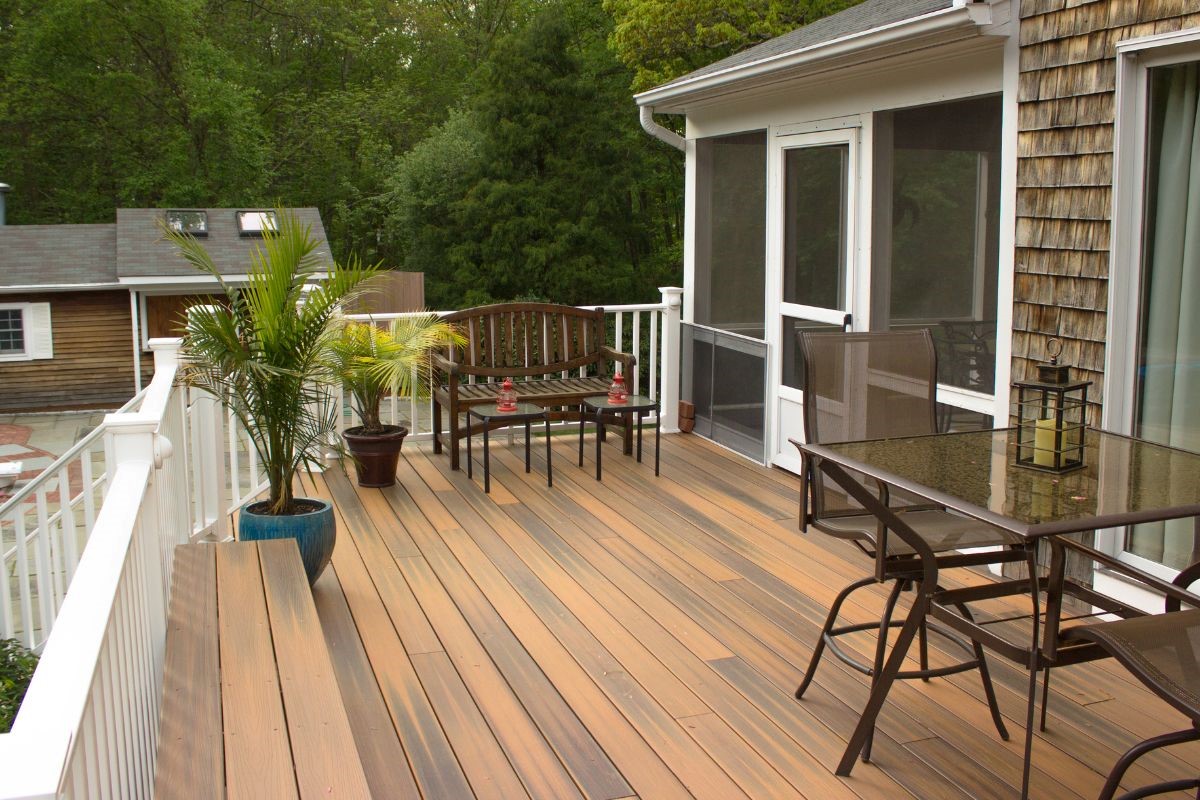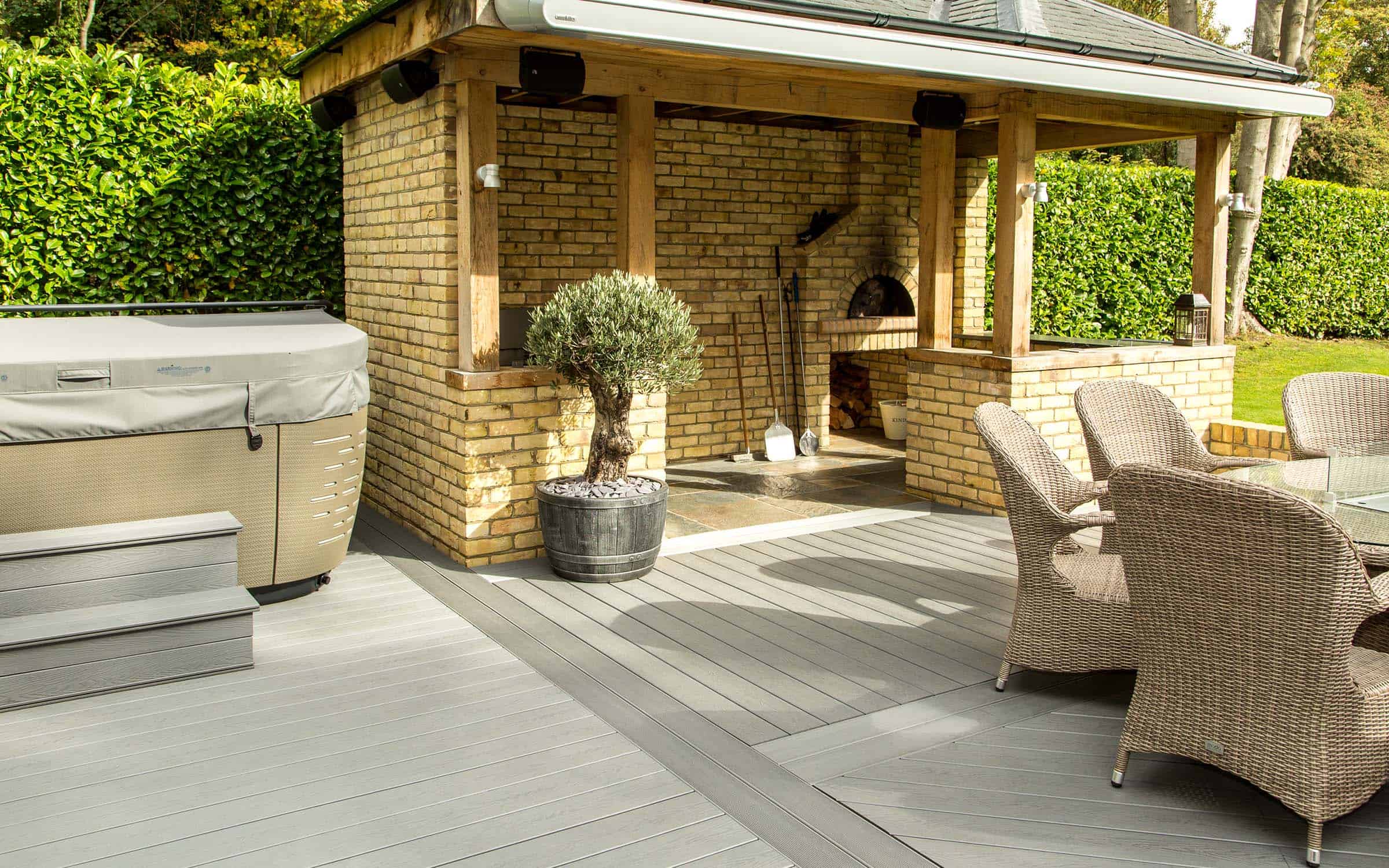Imagine walking out of your door and into another world not dissimilar to your own living space – where you wake up with the sun each morning and enjoy evenings with your closest friends. Combining a deck with a patio readjusts your backyard in a manner that encourages rest and togetherness. It may sound cliche, but selecting the right materials is one of the most important factors for beauty and longevity. For instance, grey composite decking provides a sleek, modern look, and contemporary decking has a long lifespan and does not require any regular maintenance. Here are some tips for creating an outdoor area that fits your lifestyle like a glove.
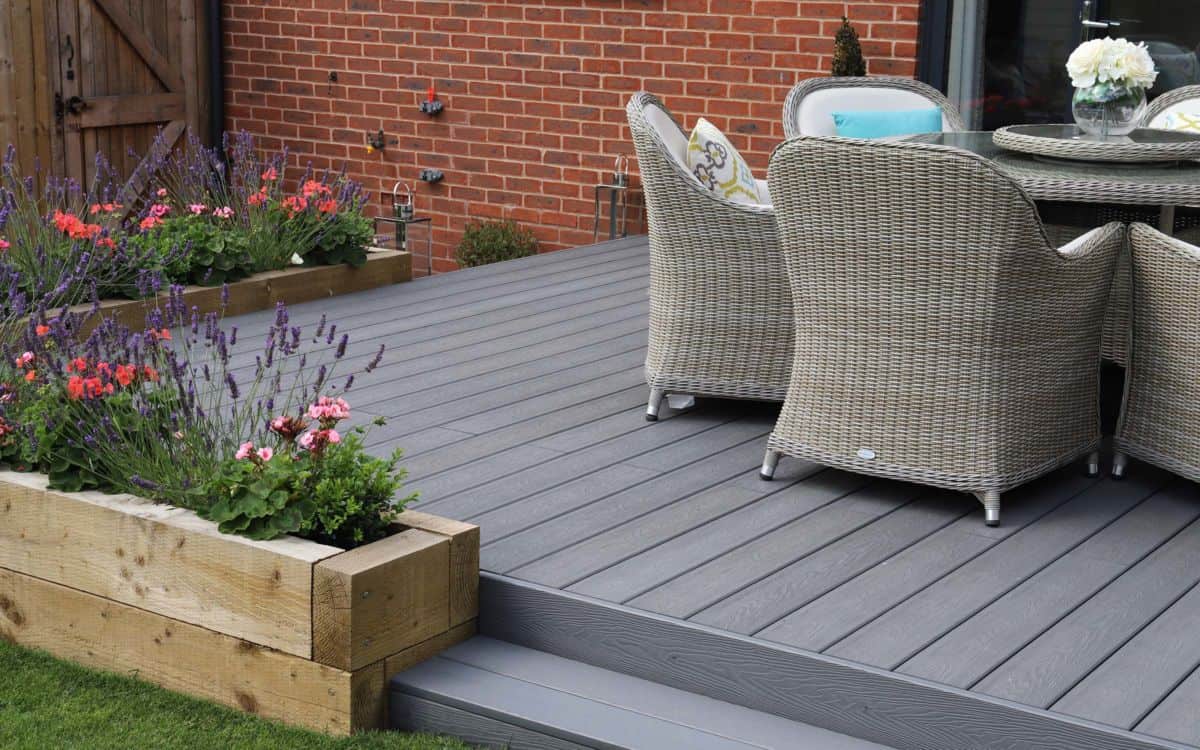 |
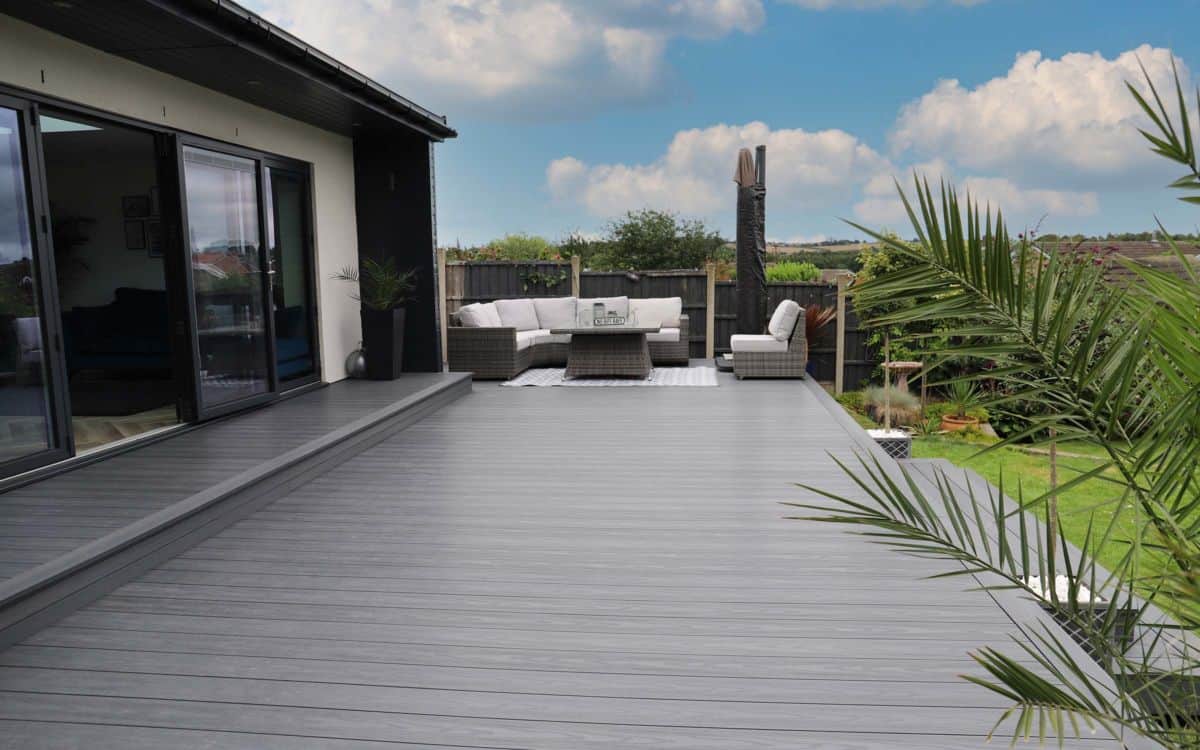 |
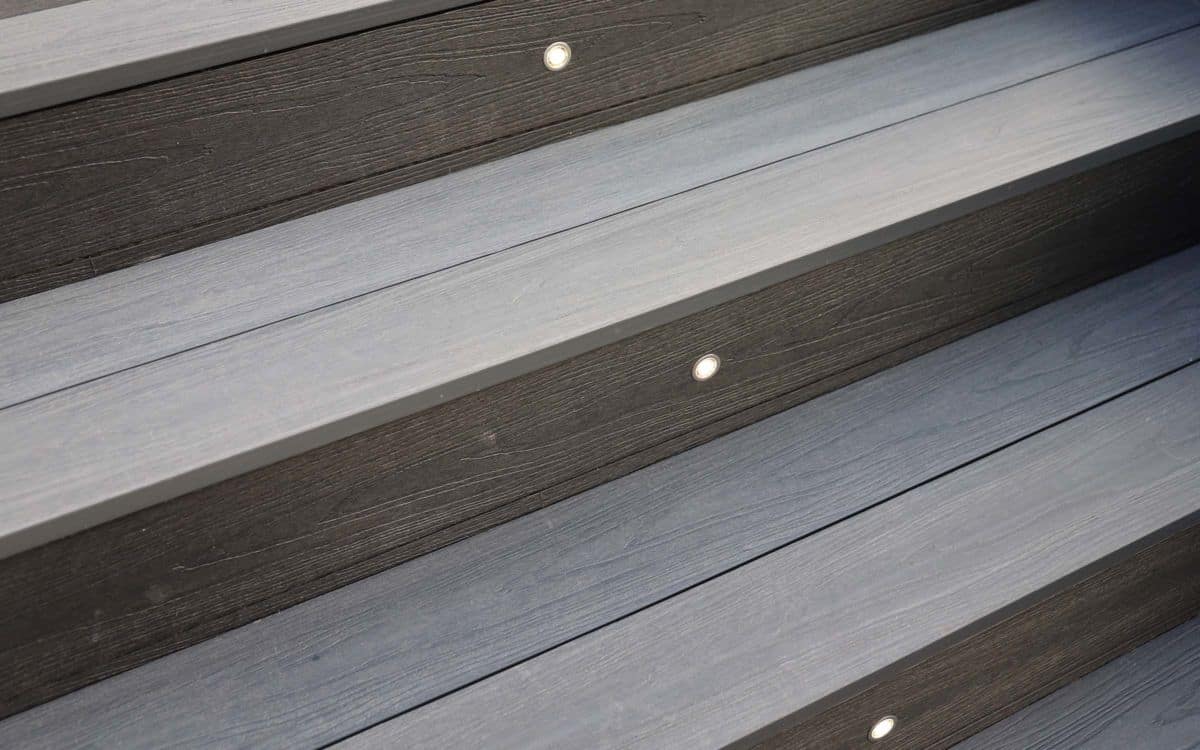 |
Make It PopAs a crisp contrast to white walls, grey composite decking is the perfect backdrop to a riot of colour. Plant flaming reds, verdant greens and outrageous oranges and see these colour tones truly pop against your sleek composite deck, exploding with personality and individuality. |
Switch Out To Tie InWhite uPVC windows are increasingly being replaced with anthracite, due to their modern look and stay-clean finish. Tie-in your exterior design with your garden. Match anthracite bi-fold doors with anthracite composite decking, light-grey composite decking or charcoal composite decking and blend indoors and outdoors together, seamlessly. |
Living On The EdgeComposite decking is designed with concealed grooves which act to secure the boards down with the fixings provided. Our edging boards prevent any unsightly grooves from spoiling the look of your deck by discreetly concealing the clip groove underneath so that just a nice clean edge is visible. |
1. The Benefits of a Deck and Patio Combination
Situating a deck adjacent to a patio creates versatility, providing homeowners with options for usable space for a number of purposes. The key advantage of this combination is that it allows full advantage of the external areas without the need to restrict them to a single feature. For instance, while a deck can offer the perception of a raised dining area or a place to lounge, the patio provides a different location for dining or hosting guests. Together with the previously described advantages, this combination not only enhances your outdoor zone in terms of dimensions and richness but also seamlessly transforms your territory into a space that can expand your home and accommodate different-scale celebrations.
Besides, a combination of a deck and patio will contribute to enhancing the value of your home. Customers looking to purchase functional furniture, outdoor kitchens, and areas for dining, relaxing, and socializing get attracted to your setup. This thoughtful design also creates clear transitions from the interior to the exterior living space, which enhances the exterior look and adds functionality to the home.
2. Assessing Your Outdoor Space: Key Factors to Consider
As a way of coming up with a deck and patio combination, consider the size of the yard and its layout. Before you start sketching the design, you should take time to get the measurements of the area you are to construct and check for any constraints that may include property demarcation lines, other buildings, or physical barriers. This data also assists in determining the area to be covered by the deck and patio so that the decking and patio area do not infringe on space required for walking paths or other constructions. In small yards, it is possible to create different levels of design to create separate areas while not overcrowding the space.
Designing and constructing the deck, patio, and garden area can be challenging at some point. Both elements should work hand in hand so that there is ample space for relaxation, dining, and yard activities. It may also be useful to incorporate garden beds, planters, or even green walls into the design to enhance the aesthetic appeal and provide a clear demarcation line between the hardscape and the softscape. This balance not only makes the space visually attractive but also ensures that all components do not interfere with each other.
Further, it would help if you considered how the natural features of your yard, including slopes, trees, and uneven ground, will affect the overall design. When it comes to a deck, this is perfect for areas that are hilly or rough, while builders best develop patios on leveled areas. This approach also allows the design to harmonize with the existing landscape, providing both functionality and aesthetically pleasing elements.
3. Choosing the Right Materials for Your Deck and Patio
The following information can help you make the right decision when choosing the best materials for the construction of your deck and patio. Common types of decks consist of wood, composite, and PVC. Cedar or redwood are good examples of wood that give a natural finish but require more frequent maintenance than composite ones to avoid weathering. Manufacturers create composite decking from wood fibers and plastic, and while it looks like wood, it is much easier to maintain and lasts longer. PVC decking is the most weatherproof, but it is costly as well. Your choice depends on how much you are willing to spend and the amount of time you are ready to invest in maintaining it.
Some of the best choices for the patio include concrete, pavers, and stones. Pavement is cheap and can imitate a variety of textures when imprinted or colored, but it can also crack. Pavers are offering more versatility in design, and you can easily replace one paver if it gets damaged. However, unlike the latter, natural stone materials have a premium appearance with outstanding durability, though at a greater expense.
In this case, to guarantee that the deck and the patio look equally good, you need to ensure that the materials used between the two are compatible. For example, if you opt for natural wood decking, using stone or paver patios next to it will give you that country-style look—composite decking pairs well with modern, smooth concrete patios.
4. Deck and Patio Layout: Creating Zones for Functionality
Sectioning your deck and patio by creating certain areas improves functionality and enhances overall circulation. The first step is to define the functional zones, which could include dining areas, relaxation areas, and entertainment zones. As for dining, just place a table with chairs near the house or an outdoor kitchen, if available. Relaxation zones may include comfortable seating options like sofas or chaises, preferably under a roof or a shaded structure. For example, areas for fire pits or playgrounds should remain more open and not occupy places where people frequently move.
Depending on the level or elevation, you can enhance the aesthetics of this design and compartmentalize these areas of usage without partitioning. For example, raising the deck over the patio or making a difference in height between the two sections separates the zones but still unifies the design. This not only increases usability but also creates a more dynamic work layout or a more interesting design.
Chosen furniture and decorations play a crucial role in properly defining outdoor zones. Exterior rugs, planters, and even light fixtures can tie each area together and give them a sense of purpose. This approach maximizes the convenience and visual appeal of every section of your outdoor environment.
5. Blending the Indoors with the Outdoors: Seamless Transitions
The connection of the interior and exterior spaces can make the house more practical and beautiful. This can effectively achieve integration through design that connects the two areas. Sliding doors or folding doors are another great way of opening up a home to the external environment and letting in light and air. These transitional elements not only offer a practical solution for movement but also visually connect the indoor and outdoor areas.
To further strengthen this relation, designers use similar design styles and color schemes in the logos. This way, you are able to create a harmonious look on your interior and exterior decks and patios. For example, having the same type of floor or at least a similar color on the outdoor furniture will give the two areas the feeling of being one big space. Plumage, wood, stone, and other natural textures and colors are also suitable for this use.
In order to improve the connection, you can do many things, including installing features like retractable awnings or using indoor-outdoor rugs that reflect the interior design. These additions are useful in blending the two spaces and creating a smooth transition from the indoors to the outdoors while making the outdoor living space more of an extension of the interior living space. This approach provides a soft, coordinated transition between the interior and exterior.
6. Incorporating Landscaping into Your Deck and Patio Design
Adding plants, trees, and greenery to a deck or patio is crucial because it helps to make the harsh edges of the structure more appealing and friendly. They help to soften the look of the hardscape elements and introduce elements of life to the area through the means of texture and color. Some trees provide shade and even a feeling of privacy, while more petite plants enhance the lush feel of the corners of the space.
For more privacy and to make the area look less plain, it might be useful to include planter boxes, vertical gardens, or trellises. Planters positioned on the deck railing or the edge of the patio will give the space a sense of more confinement, which is quite desirable. It is best for those who have limited area; they can create greens and beauty without occupying the ground space. Climbing plants such as Clematis, Honeysuckle, and Wisteria on trellises are beautiful and can also provide some privacy when you place them between seating areas.
Therefore, it is important to balance the aspects of hardscape and landscaping in order to get the right look for the outdoor space. Do not fill the area with many plants, and provide a smooth transition between the paved zones and planting zones. With proper strategy, when incorporating plants into the design of the hardscape, you can create a beautiful and functional space.
7. Lighting Solutions: Enhancing Ambiance and Safety
It is essential to dedicate some time to choosing the right lighting options for our outside areas both for aesthetic purposes and safety. Lighting up a deck and patio ensures that there is no tripping over, especially where there are walkways or steps, a dim light can create a good environment for relaxing or even having some company. The right mix of functional and decorative lights makes your outdoor living area both useful and beautiful for you to use in the evening.
Outdoor lighting has several categories based on their particular use and purpose. These include pendant lights, which light up the dining or cooking area, and outdoor chandeliers, which offer coverage for the same areas. String lights are perfect for giving off a warm and subtle light and are ideal for use as decoration. Lanterns deliver a form of lighting that allows you to relocate them easily from one area to another, while deck or patio floor lights are great for use in the identification of paths or stairs, giving light as well as elegance.
Strategically placing your lights is key to achieving the desired effect. Distinguish most dynamic regions like sitting spaces or approaches and apply dimmer lights to make the area less occupied and cozier. This careful positioning makes your exterior area cozy and protected at the same time.
8. Adding Features for Comfort and Entertainment
Adding on features such as a kitchen, fireplaces, and water can enhance the deck and patio experience. An outdoor kitchen provides convenience through food preparation and eating; thus, it is ideal for people with entertainment in mind. Fire pits are a great way to have a central place for people to gather around at night and create a warm atmosphere. Home accessories like water features, such as fountains or little ponds, make the space more relaxing and pleasant.
To make your outside area functional throughout the year, you should have pergolas, shade sails, or awnings. Pergolas are semi-covered structures that shield you from direct sun but still allow a great deal of airflow. Shade sails are a contemporary and versatile approach to sun protection and shade, and retractable awnings enable the user to control the amount of sun and or rain penetration. These features help you use the deck and patio even during extreme weather conditions.
Other features that add an entertainment factor include sound systems and outdoor TVs, which are great additions to the space. An excellent sound system can help you play music or podcasts while you are outside. However, an outdoor TV provides a means of having movie nights or watching major sports events with friends and family, making the outside area a recreational center.
9. Sustainability in Outdoor Space Design: Eco-Friendly Options
A well-designed landscape may be environmentally friendly, making it a valuable asset to your home, and you will yield gains in the future. To begin with, you can use recycled composite decking, reclaimed wood, or permeable pavers for patios and decks. These materials are less wasteful and require less energy to manufacture compared to other products. Also, including features like solar lights to reduce electricity use will illuminate your outdoor space nicely at night.
Another good method to enhance the sustainability of your deck and patio is rainwater harvesting. By installing a rain barrel, you can gather and use water for watering plants, thus saving water. This green initiative also strengthens the use of plants that do not demand much water. These plants grow well in the area, minimizing the maintenance and utilization of resources such as water and fertilizers.
It is essential to free some space where the local fauna could live to preserve the natural balance. When you plant native shrubs, trees, or pollinator-friendly flowers, you are inviting birds, bees, and butterflies. It also makes the environment look beautiful, thus contributing to the reduction of your carbon footprint and supporting the growth of better ecosystems.
10. Budgeting for Your Deck and Patio Project: Smart Investments
Estimating for your deck and patio, identifying major cost drivers, as well as the cost of materials and labor, and getting the necessary permits. Decks and fences can use several products, including wood, composite, or stone, where the cost can be rather high. For instance, natural lumber may cost less initially than composite, but you will need to reseal and maintain natural wood more often than composite decking. Depending on the complexity of the design and the contractor’s fees, labor costs apply, and municipal bodies mostly demand permits.
You should spend money wisely, and since you want to achieve the most within the given amount of money you have, you should focus most of your spending on those aspects that will be of the utmost use. If eating outdoors is a prerequisite, then using hardwearing furniture for the patio could be a priority. If the main aim is relaxation and dozing off, then the building of a proper deck with an adequately furnished sitting area should be of paramount importance.
This means that you plan for durability over the long term to minimize maintenance or replacement costs. Select the material that is not easily affected by weather and tear, such as the composites for decks and stone pavers. This approach ensures that your investment adds more value, and you do not need to repair or replace them often.
Creating Your Ideal Outdoor Living Space
They all come down to one important reminder as you plan your budget for your deck and patio projects – it’s not only about money. It is about the quality, longevity, and functionality of your outdoor living areas. These are some of the ways to choose long-lasting materials and focus on the places where people spend most of their time – dining, lounging, or entertaining – your outdoor space turns into a complementary addition to your home.
When designing a house, it is logical to create a main deck area in conjunction with a patio so that you receive all the advantages without compromising aesthetic emotions. For this reason, outdoor spaces can adapt to your lifestyle, just like interior living spaces, providing comfort and adaptability. Not only a cozy fireplace, which is perfect for family meetings, or a serious dining area, which is ideal for hosts – several pieces of furniture combined with the necessary conditions will make your investment safe and long-term.
By strategically designing and managing your own space, your outdoor oasis can serve as a place to relax and bond for several years. If you had the chance to redesign the deck and patio in our compound, what design would you give it? That is the time to start planning and begin transforming your vision into real life.


